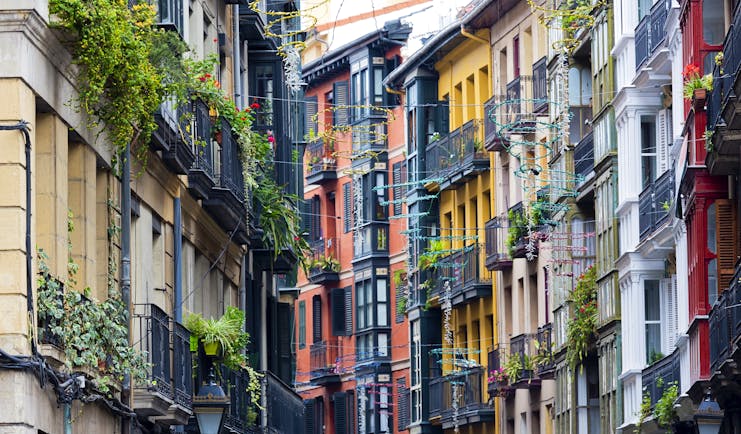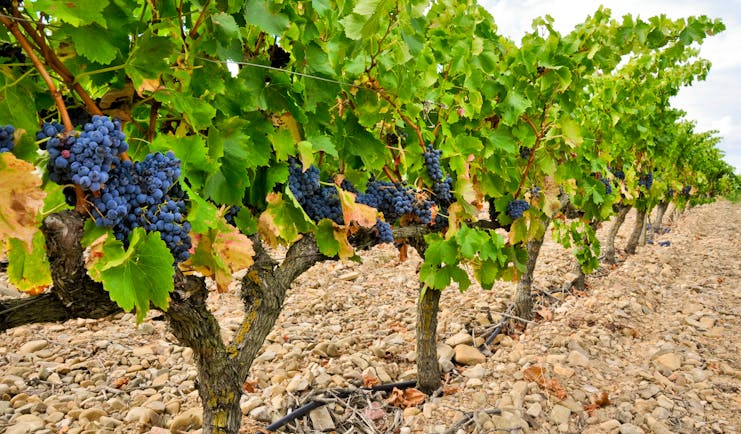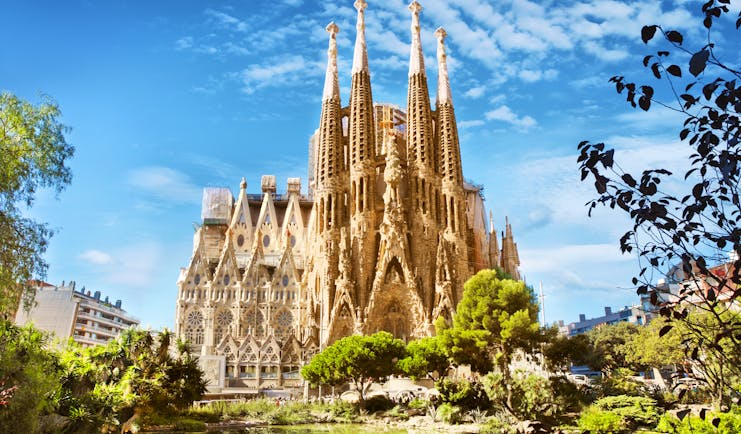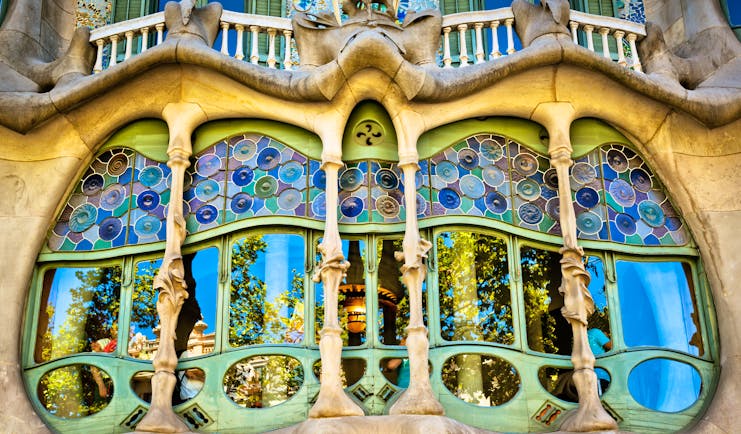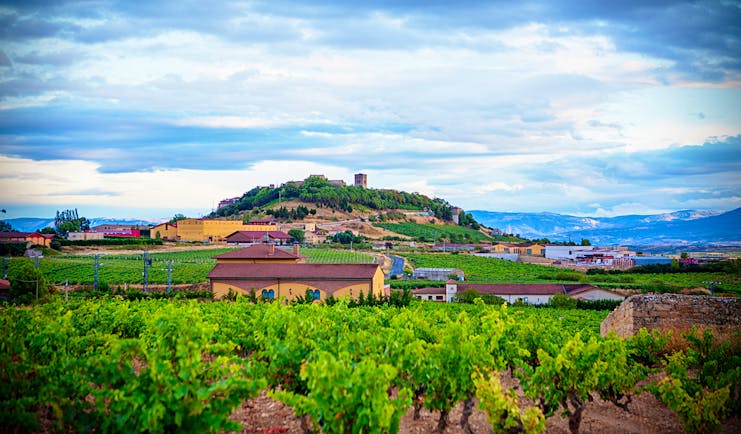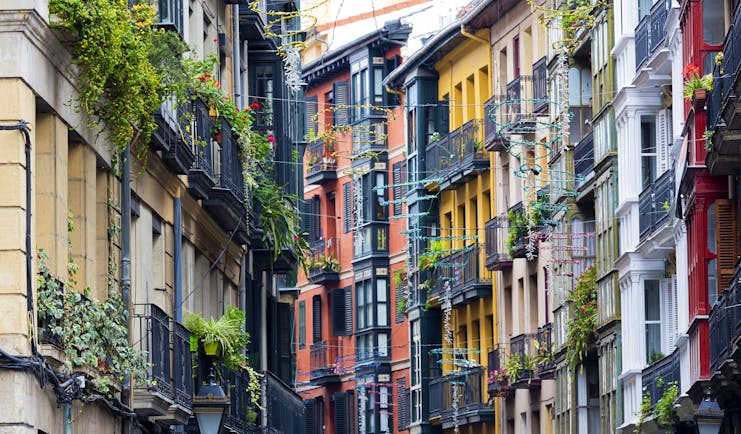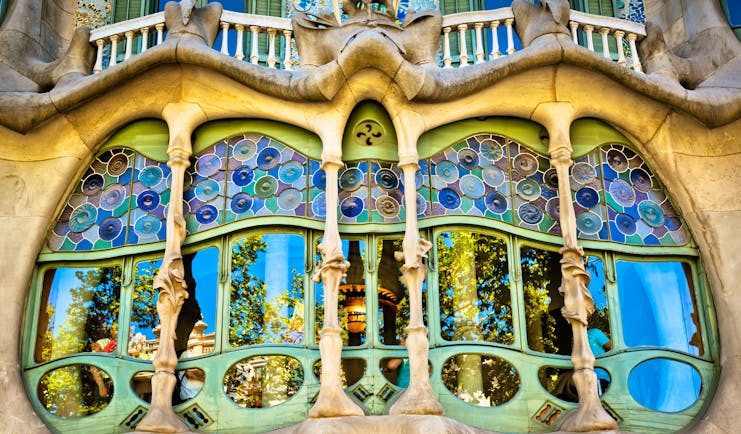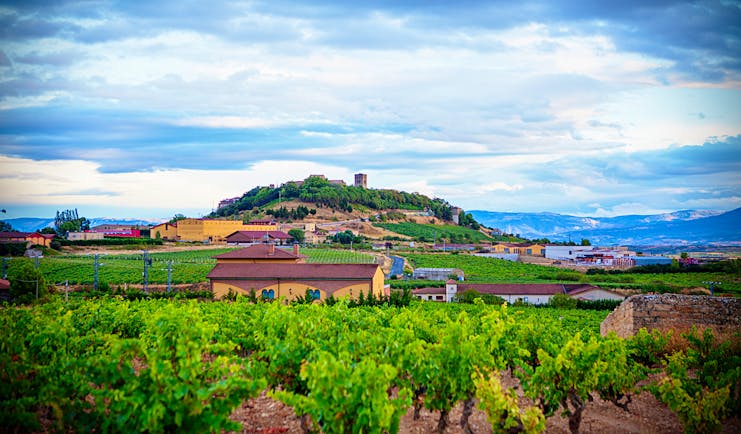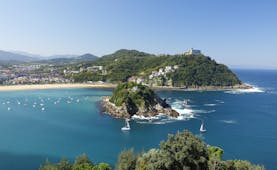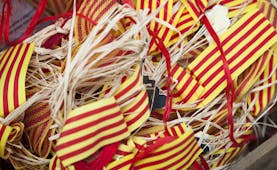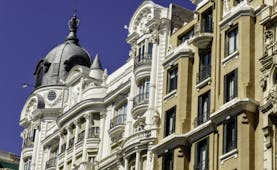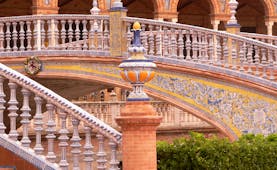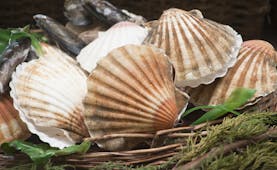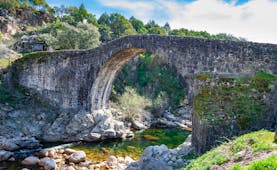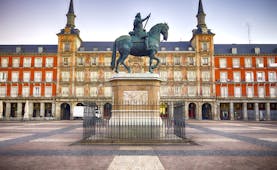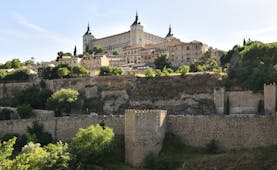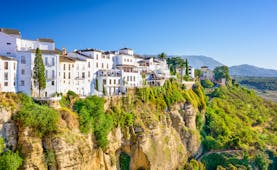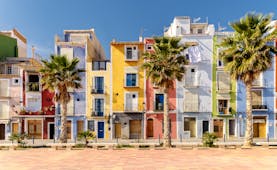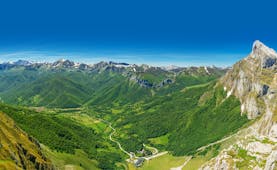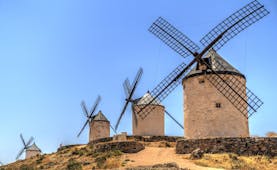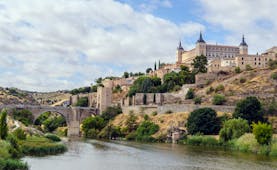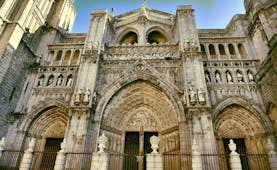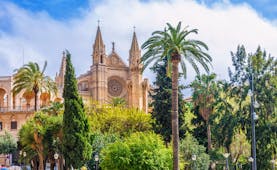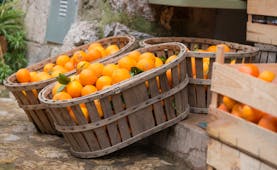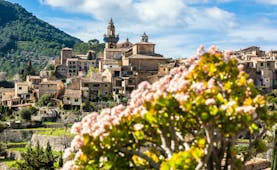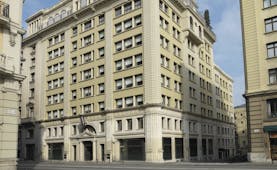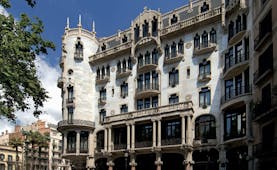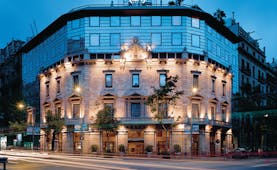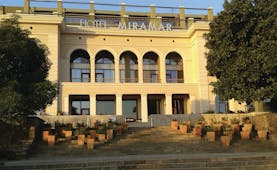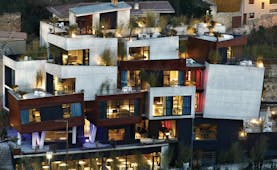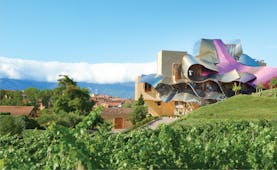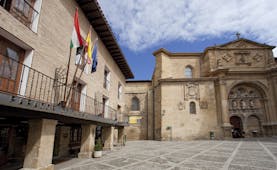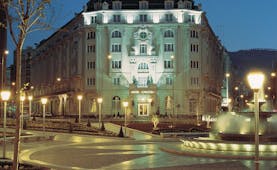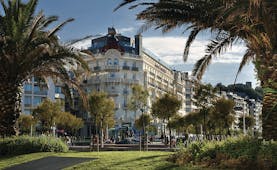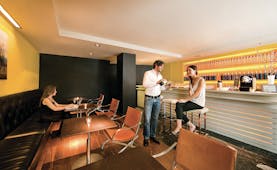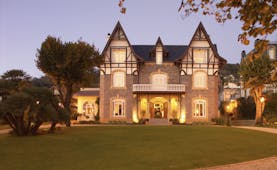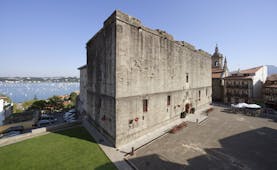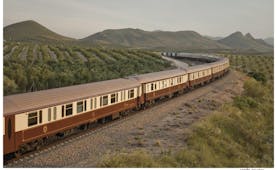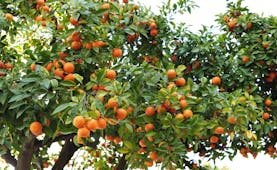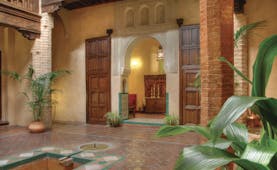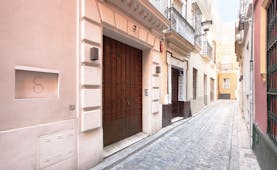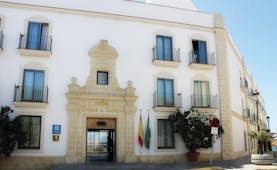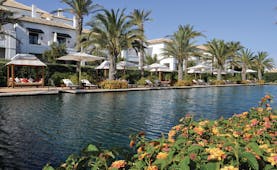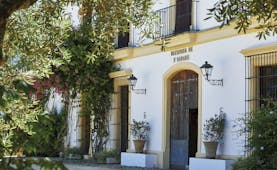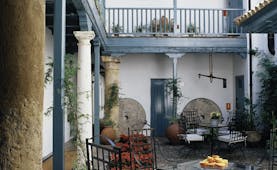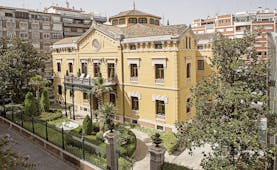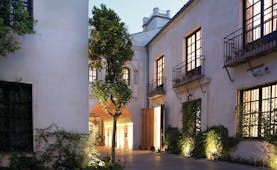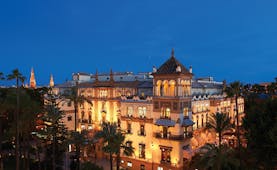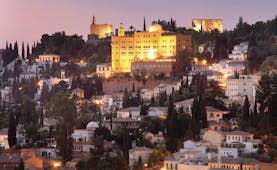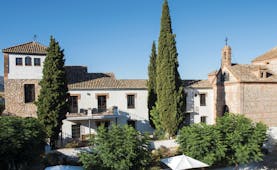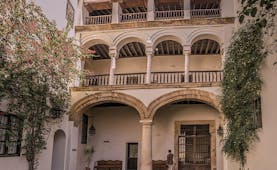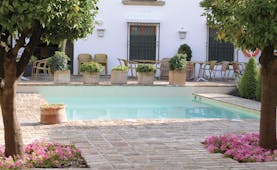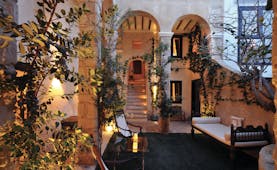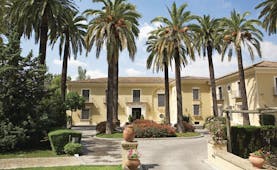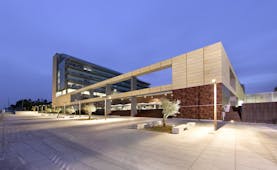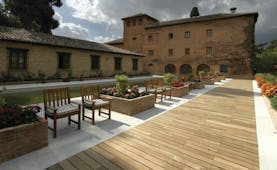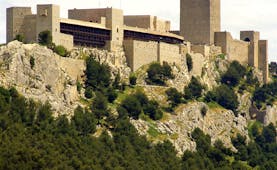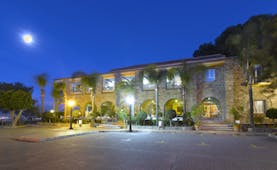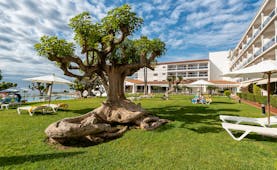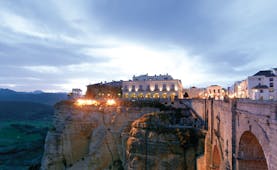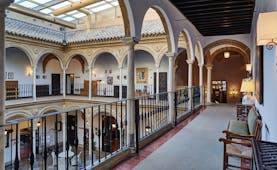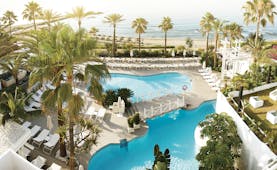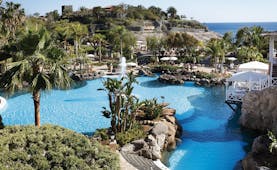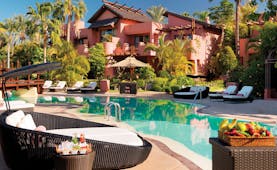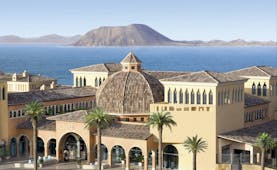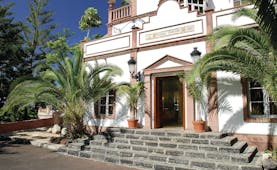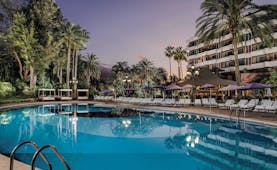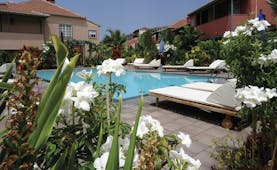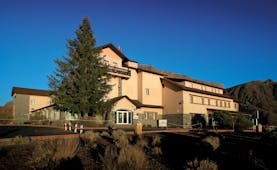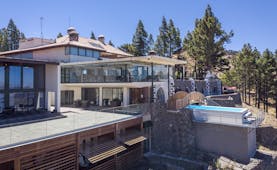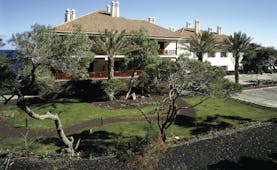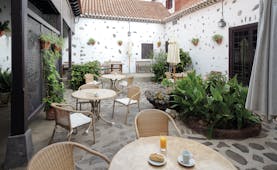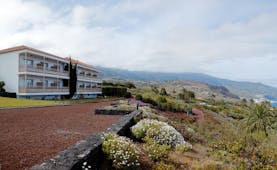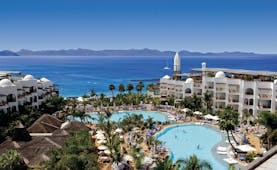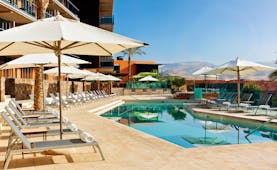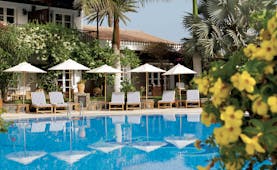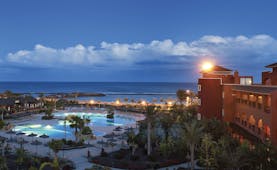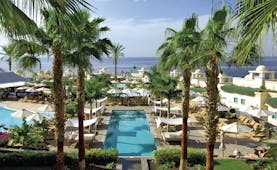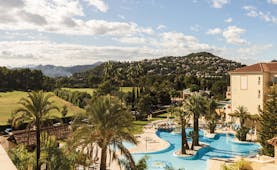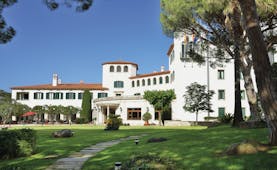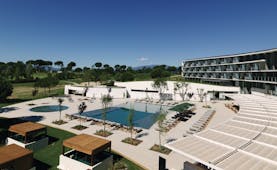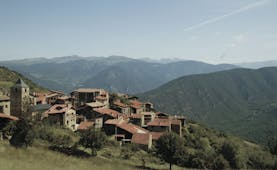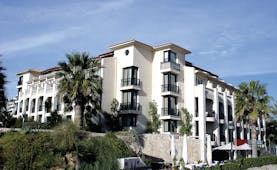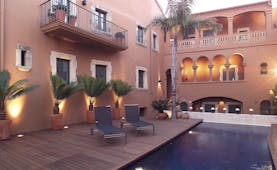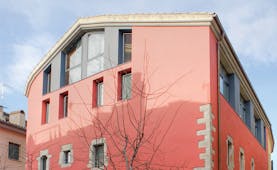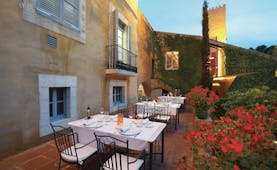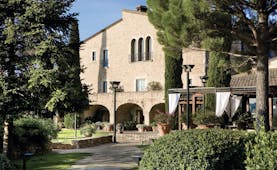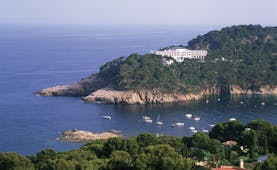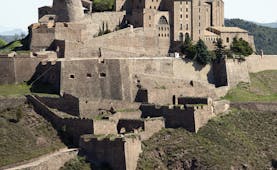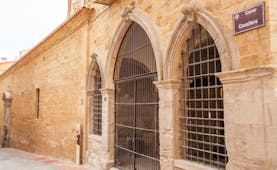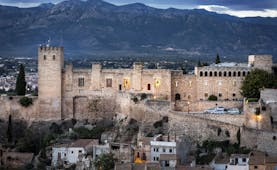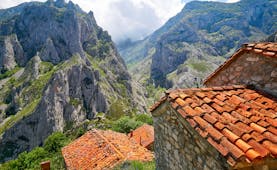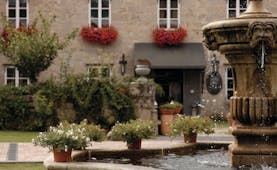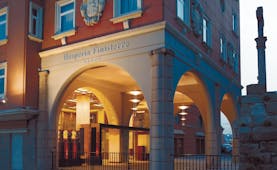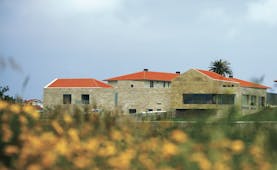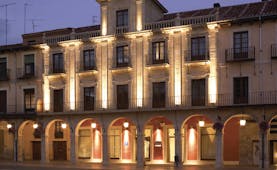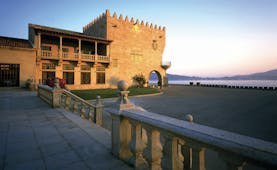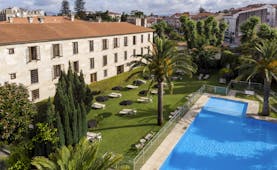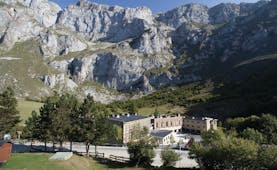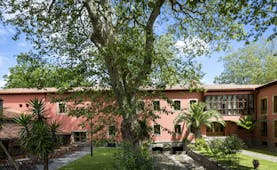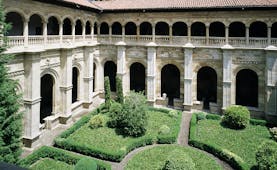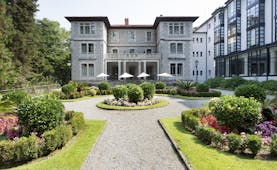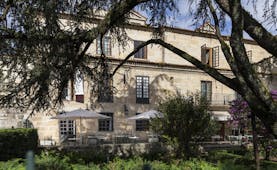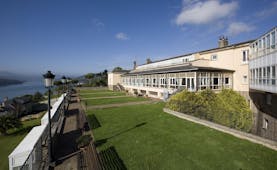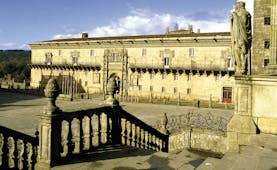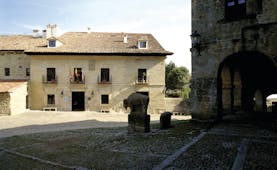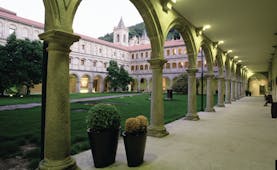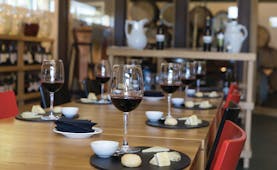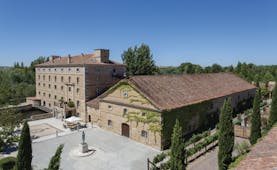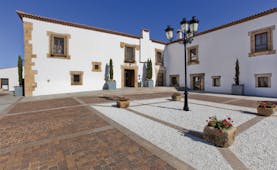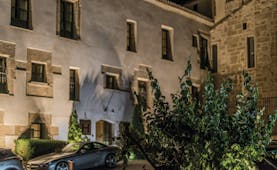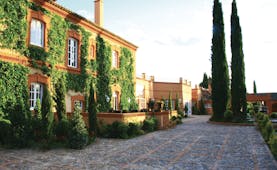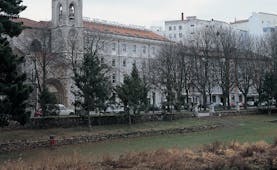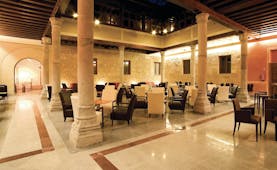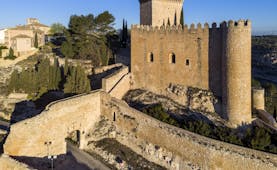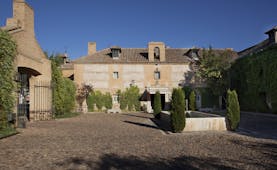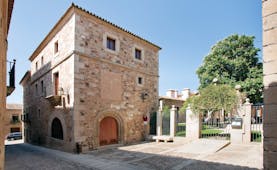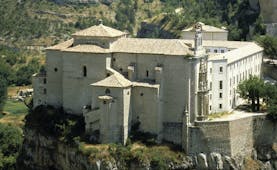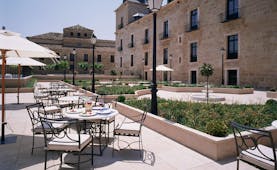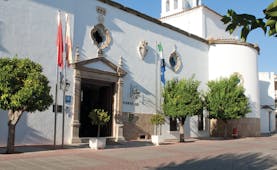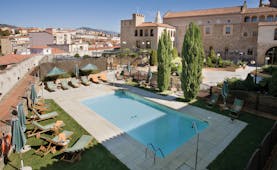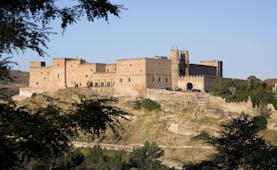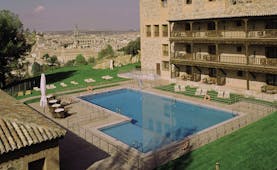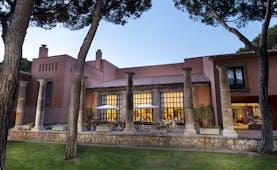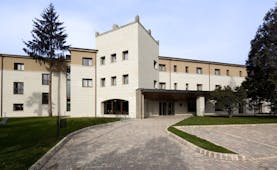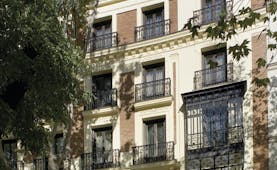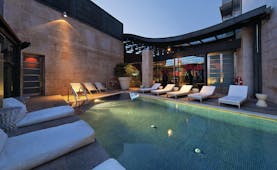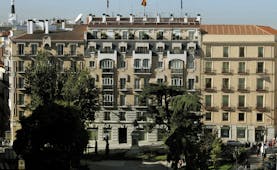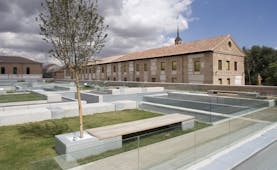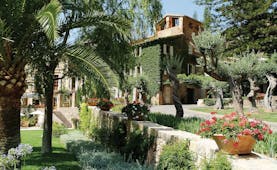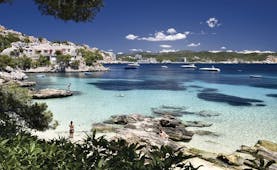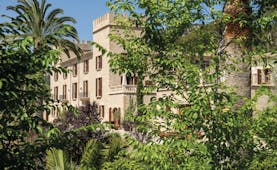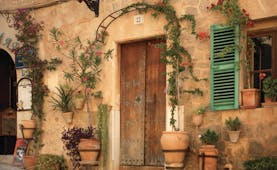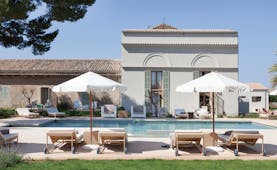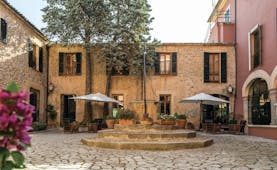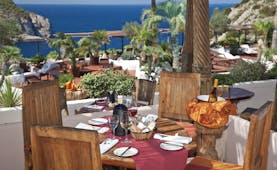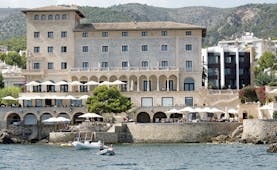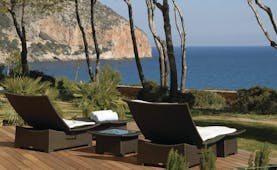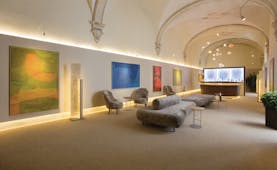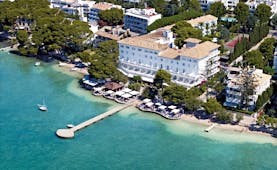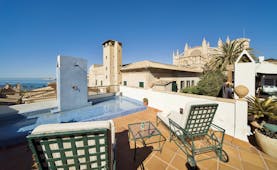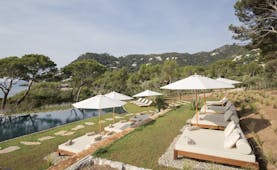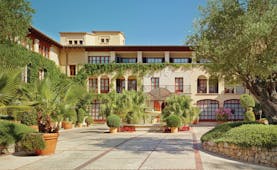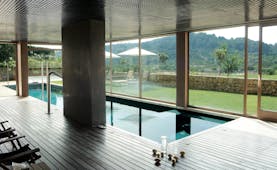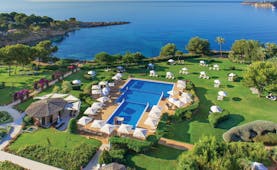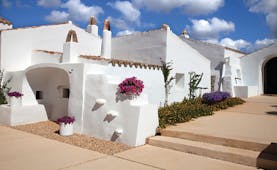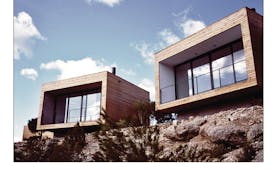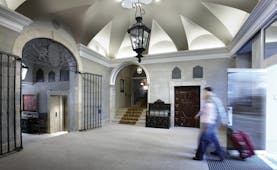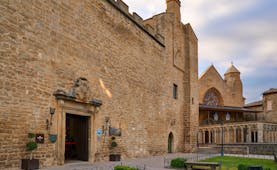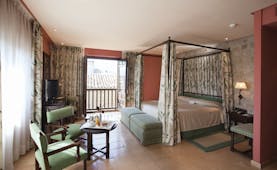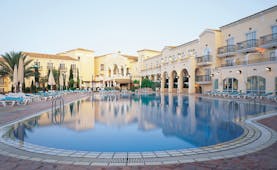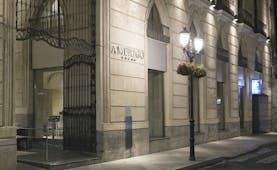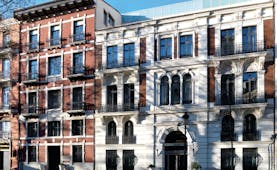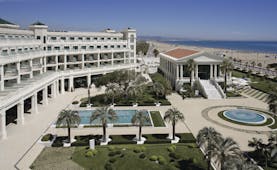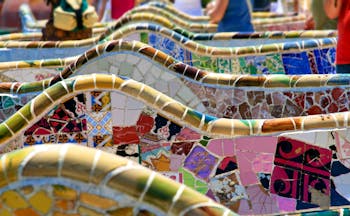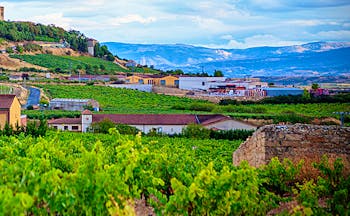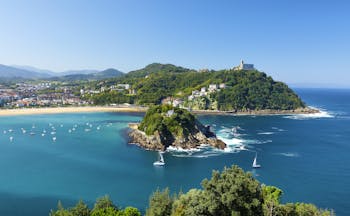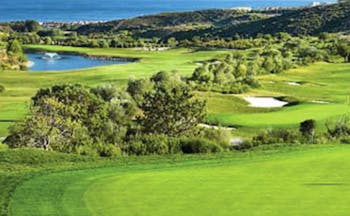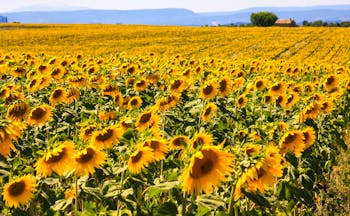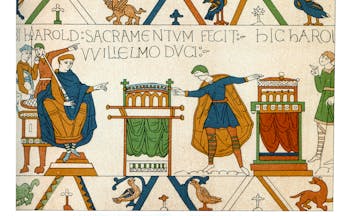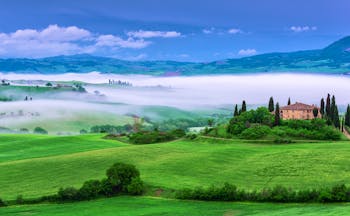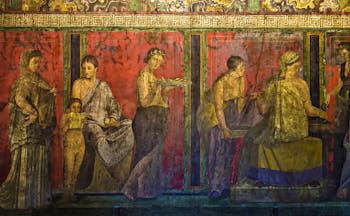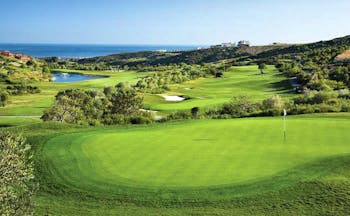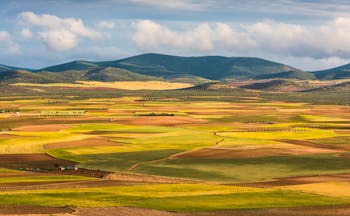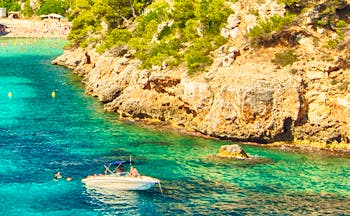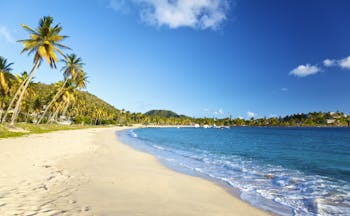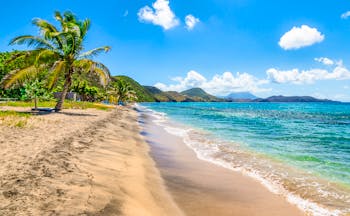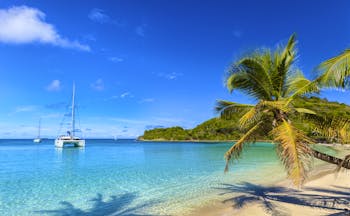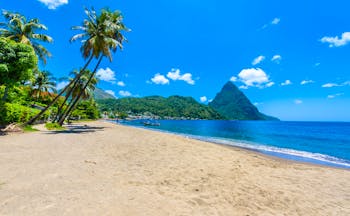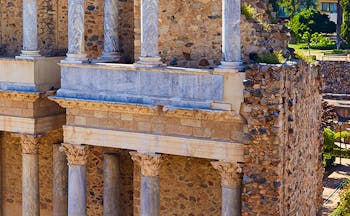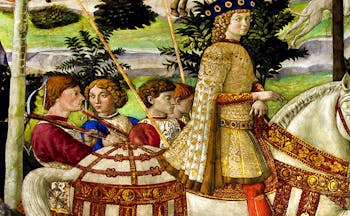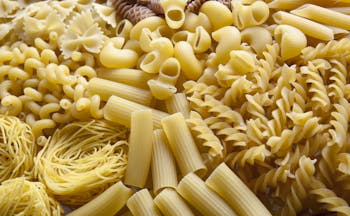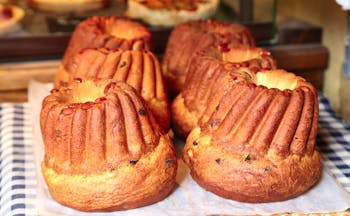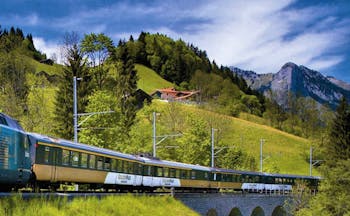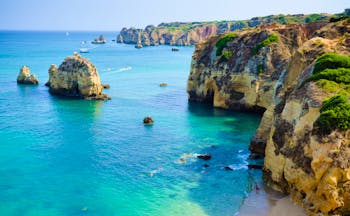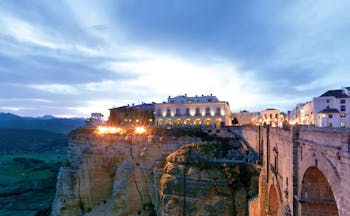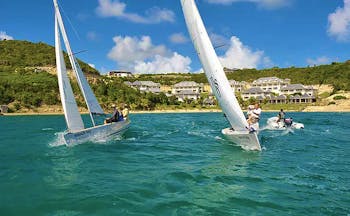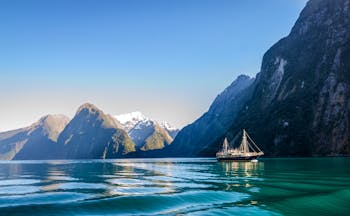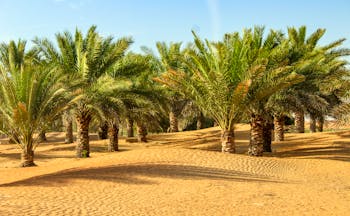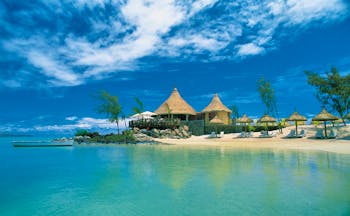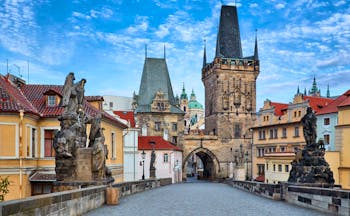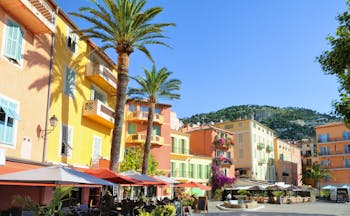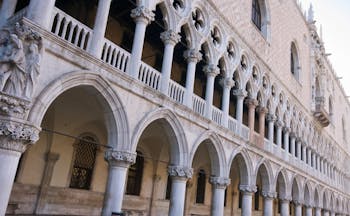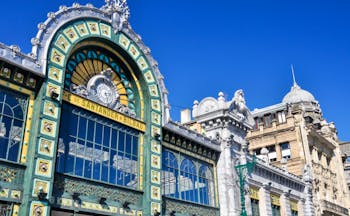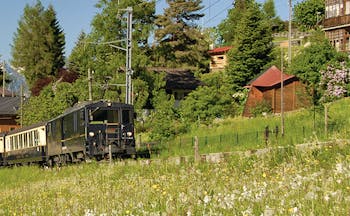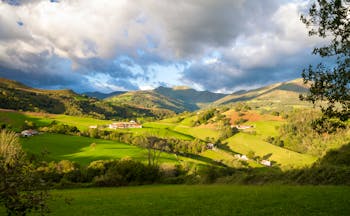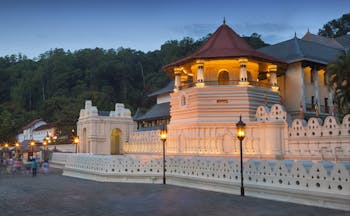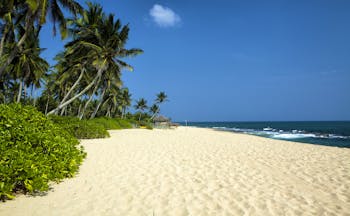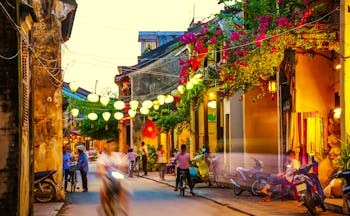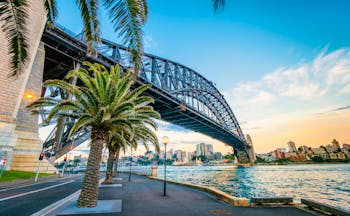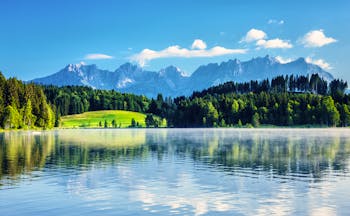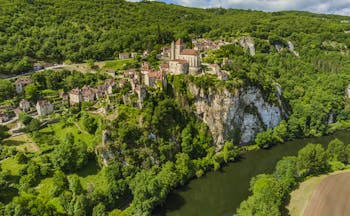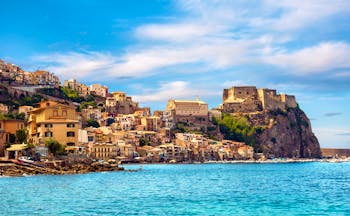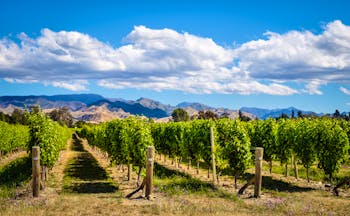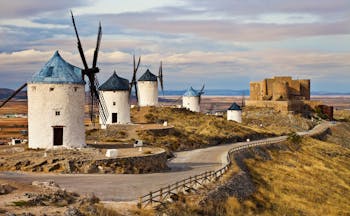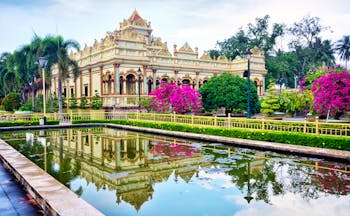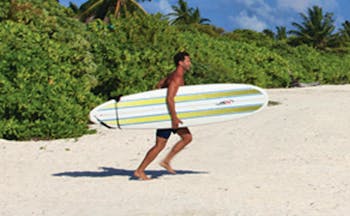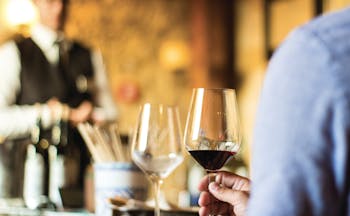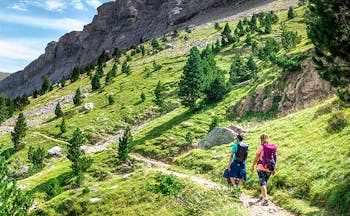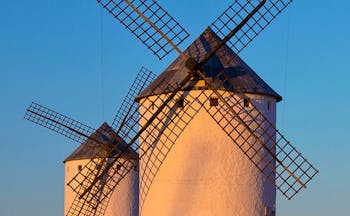Luxury touring holiday by train to Barcelona, the vineyards of La Rioja and Bilbao, returning by air
This 8-night rail holiday to the Catalan capital, Barcelona, the vineyards of La Rioja and the Basque city of Bilbao covers the distance from London through to Bilbao by train, with the use of a hire-car for a few days to explore the Rioja vineyards. Your journey starts on the Eurostar from London to Paris, with a change of trains and then you speed southwards through France to Barcelona. You have three nights in Barcelona to tease out the highlights of this cultural centre of Catalonia. Navigate winding mediaeval streets, seek out Gaudi’s most recognisable masterpieces, and dine on traditional Catalan cuisine on the promenade of a Blue Flag beach. From here, travel by train to Logrono, pick up your hire car, and drive further into the lush La Rioja countryside. Spend three nights amidst the vineyards of the striking Marques de Riscal in Elciego, or at the Hotel Viura, enjoying the finer things in life and basking in the Mediterranean sunshine. Use this stop as an opportunity to sample the best of the local cuisine. Drive back to Logrono and return your hire car after your stay, before boarding a train west to Bilbao. This thriving city is an artistic and cultural hub in northern Spain, and your hotel options for the next two nights, the Hotel Carlton or the Hotel Miro, are both within easy walking distance of the famous Guggenheim Museum. Explore the bustling city centre, enjoying the artistic heritage captured by various museums and galleries, and perhaps take a day trip out to gastronomic San Sebastian. From Bilbao airport, board your return flight to London, which marks the end of this luxury touring holiday. It is also possible to return home by train.
Highlights
Barcelona • Parc Güell • Montjuic • La Rioja •Logrono • Elciego • Bilbao • Guggenheim • Mercado de la Ribera
Day by day
Start your luxury rail holiday to Spain by leaving London St Pancras about 8am and travelling on the Eurostar to Paris Gare du Nord. Take a taxi to Paris Lyon station to catch the daytime train to Barcelona, where you arrive just before 9pm. You have a choice of centrally located hotel for three nights.
Spend two days exploring this vibrant and attractive city. There are many ‘must-see’ attractions in Barcelona, which make for a hugely exciting stay. Discover the modernista architecture of Gaudi and his contemporaries by visiting the Parc Güell in the Zona Alta with its fluid mosaics and bright colours, the more reserved Palau Güell in El Raval, and, of course, the iconic Sagrada Familia church which scores the Barcelonan skyline in the Eixample. Its fairy-tale exterior gives way to a cavernous and captivating interior built in the shape of a traditional Latin cross. Walk along the famous La Rambla to enjoy the quirky shops and street entertainment, as well as to sample the Catalan cuisine. The La Boqueria Market is famed for its oysters. Spend a few hours one morning exploring the maze-like mediaeval Gothic quarter, seeking out the enchanting squares, the palaces, and the excellent shops that punctuate the winding pathways. Perhaps visit the museums of La Ribera, which were once the palaces of merchants, or the Romanesque monastery of Sant Pau in El Raval. Pass the modernista architecture that lines the Passeig de Gràcia on your way to the Sagrada Familia or take in the sombre elegance of the Montjuic Castle. The Montjuic quarter is also home to the minimalist Fundació Joan Miró, and the recently established Museu Nacional d’Art de Catalunya. In the evenings, enjoy the best seafood in Barcelona in one of the chic restaurants that line the promenades on any one of the 6 Blue Flag beaches. Once you have got your fill of Barcelona, perhaps take an afternoon excursion to one of the towns and cities nearby, such as Girona, Vic or Figueres, home of the Dali Museum.
In Barcelona, board a train at about 2pm, which will take you north-west across northern Spain, passing Lleida and Zaragoza in the Ebro valley on the way to Logrono, where you will arrive just before 6pm. On arrival in the capital of La Rioja, collect a hire-car and continue to the Marques de Riscal, a strikingly modern hotel which forms part of a long-established winery, or the Hotel Viura, another striking hotel with a geometric, chaotic façade to contrast the fluid metallic lines of the Marques. You spend three nights in La Rioja.
You have two full days to spend in La Rioja, which will provide plenty of time to relax, explore the countryside, and visit the nearby towns and villages. In the small village of Elciego, the main cultural attraction, aside from the vineyards, may be the Parish Church of Elciego. Though it is unassuming from the outside, the inside is given a charming golden glow by the Retablo Mayor. The Plaza Mayor in Elciego is a mysterious square far removed from the hustle and bustle of the larger nearby towns, with a highly affecting feeling of peace and quiet. You are perfectly placed to visit the Yuso and Suso Monsteries, which are atmospheric terracotta coloured building amist the rolling green hills and valleys of a wine region famous since Roman times. The nearby villages of Santo Domingo de la Calzada, situated on the Saint James Pilgrimage Route to Santiago de Compostela, has numerous quiet streets and peaceful plazas that make for a thoroughly relaxing few hours excursion. For a taste of the more lively nearby towns, Logrono makes a very fulfilling day out. We recommend visiting the Concatedral de Santa Maria de la Redonda, whose main façade was designed to resemble an altarpiece. The two front towers, known as Las Gemelas, or ‘the twins,’ were built in the Baroque style, and inside, there is a painting of the crucifixion by Michelangelo. The Santo Sepulcro in one of the cathedral’s chapels is unusually detailed in tortoiseshell, silver, and wood. This three night stay in Elciego or Villabuena de Alava offers an insight into a pocket of culture that forms and maintains one of Spain’s most famous industries. The dynamic, contemporary design of both hotels and the large windows that open each room out onto the vineyards ensure the utmost comfort after you have dined in either the Michelin-starred restaurant at the Marques de Riscal or in the indulgent restaurant at Hotel Viura.
Return your hire car to Logrono station before catching a mid-morning train northwards to Bilbao, a journey of around two and a half hours. Stay at the Hotel Carlton, or the Hotel Miro, for two nights, both of which are stylish hotels in privileged locations just a short walk from the Guggenheim Museum.
Take time to explore the Basque city’s sights, perhaps starting with a visit to the Guggenheim itself, which will offer a valuable introduction to the city’s opulent heritage. Designed by Frank Gehry, this futuristic building, with its shimmering curves of titanium and glass, is home to a permanent collection of contemporary art and regularly hosts temporary exhibitions. Only a few minutes’ walk away from the hotel is the Bilbao Fine Arts Museum, which houses an extensive collection ranging from 12th Century sculptures to 20th Century paintings and is a picturesque building in its own right. Along the riverbank is Bilbao’s old town. Comprised of tightly-packed colourful houses, and long, steep stairways, this part of the city takes you back to a more traditional Spain. Also worth a visit is the Gothic Santiago Cathedral, which dates back to the 14th century. This building’s front framed archway mirrors the beautiful criss-crossed arches of the ceiling within, and the circular window above the door lets in an ethereal light. Head down towards the seafront to see the eclectic Mercado de la Ribera, the largest covered market in Europe. It was built in 1929 and still sources some of the best seafood in Bilbao. The city has a vibrant evening scene with bars and restaurants, offering a more cosmopolitan vibe after your peaceful stay in La Rioja. After taking in the views across the river and in the squares, return to the grand and welcoming Hotel Carlton, which seamlessly blends the traditional and the contemporary aspects of Bilbao, or the ultra-modern and chic Hotel Miro.
Perhaps enjoy breakfast in one of the city centre cafes to make the most of your final morning in Bilbao. Then, take a taxi to Bilbao airport for your flight back to London.
I enjoyed every minute of the tour. Cindy-Marie was simply fantastic and her knowledge, kindness and humour was all that I could have asked for. This was a first class experience. Thank you for making it all happen.Customer on Tuscan wine tour, June 2022
Holiday price guide Prices from £1,860 per person based on two people sharing a double or twin room.
Holiday Code SNBR01
Call us on 01392 441245
Luxury touring holiday by train to Barcelona, the vineyards of La Rioja and Bilbao, returning by air
Start your luxury rail holiday to Spain by leaving London St Pancras about 8am and travelling on the Eurostar to Paris Gare du Nord. Take a taxi to Paris Lyon station to catch the daytime train to Barcelona, where you arrive just before 9pm. You have a choice of centrally located hotel for three nights.
Spend two days exploring this vibrant and attractive city. There are many ‘must-see’ attractions in Barcelona, which make for a hugely exciting stay. Discover the modernista architecture of Gaudi and his contemporaries by visiting the Parc Güell in the Zona Alta with its fluid mosaics and bright colours, the more reserved Palau Güell in El Raval, and, of course, the iconic Sagrada Familia church which scores the Barcelonan skyline in the Eixample. Its fairy-tale exterior gives way to a cavernous and captivating interior built in the shape of a traditional Latin cross. Walk along the famous La Rambla to enjoy the quirky shops and street entertainment, as well as to sample the Catalan cuisine. The La Boqueria Market is famed for its oysters. Spend a few hours one morning exploring the maze-like mediaeval Gothic quarter, seeking out the enchanting squares, the palaces, and the excellent shops that punctuate the winding pathways. Perhaps visit the museums of La Ribera, which were once the palaces of merchants, or the Romanesque monastery of Sant Pau in El Raval. Pass the modernista architecture that lines the Passeig de Gràcia on your way to the Sagrada Familia or take in the sombre elegance of the Montjuic Castle. The Montjuic quarter is also home to the minimalist Fundació Joan Miró, and the recently established Museu Nacional d’Art de Catalunya. In the evenings, enjoy the best seafood in Barcelona in one of the chic restaurants that line the promenades on any one of the 6 Blue Flag beaches. Once you have got your fill of Barcelona, perhaps take an afternoon excursion to one of the towns and cities nearby, such as Girona, Vic or Figueres, home of the Dali Museum.
In Barcelona, board a train at about 2pm, which will take you north-west across northern Spain, passing Lleida and Zaragoza in the Ebro valley on the way to Logrono, where you will arrive just before 6pm. On arrival in the capital of La Rioja, collect a hire-car and continue to the Marques de Riscal, a strikingly modern hotel which forms part of a long-established winery, or the Hotel Viura, another striking hotel with a geometric, chaotic façade to contrast the fluid metallic lines of the Marques. You spend three nights in La Rioja.
You have two full days to spend in La Rioja, which will provide plenty of time to relax, explore the countryside, and visit the nearby towns and villages. In the small village of Elciego, the main cultural attraction, aside from the vineyards, may be the Parish Church of Elciego. Though it is unassuming from the outside, the inside is given a charming golden glow by the Retablo Mayor. The Plaza Mayor in Elciego is a mysterious square far removed from the hustle and bustle of the larger nearby towns, with a highly affecting feeling of peace and quiet. You are perfectly placed to visit the Yuso and Suso Monsteries, which are atmospheric terracotta coloured building amist the rolling green hills and valleys of a wine region famous since Roman times. The nearby villages of Santo Domingo de la Calzada, situated on the Saint James Pilgrimage Route to Santiago de Compostela, has numerous quiet streets and peaceful plazas that make for a thoroughly relaxing few hours excursion. For a taste of the more lively nearby towns, Logrono makes a very fulfilling day out. We recommend visiting the Concatedral de Santa Maria de la Redonda, whose main façade was designed to resemble an altarpiece. The two front towers, known as Las Gemelas, or ‘the twins,’ were built in the Baroque style, and inside, there is a painting of the crucifixion by Michelangelo. The Santo Sepulcro in one of the cathedral’s chapels is unusually detailed in tortoiseshell, silver, and wood. This three night stay in Elciego or Villabuena de Alava offers an insight into a pocket of culture that forms and maintains one of Spain’s most famous industries. The dynamic, contemporary design of both hotels and the large windows that open each room out onto the vineyards ensure the utmost comfort after you have dined in either the Michelin-starred restaurant at the Marques de Riscal or in the indulgent restaurant at Hotel Viura.
Return your hire car to Logrono station before catching a mid-morning train northwards to Bilbao, a journey of around two and a half hours. Stay at the Hotel Carlton, or the Hotel Miro, for two nights, both of which are stylish hotels in privileged locations just a short walk from the Guggenheim Museum.
Take time to explore the Basque city’s sights, perhaps starting with a visit to the Guggenheim itself, which will offer a valuable introduction to the city’s opulent heritage. Designed by Frank Gehry, this futuristic building, with its shimmering curves of titanium and glass, is home to a permanent collection of contemporary art and regularly hosts temporary exhibitions. Only a few minutes’ walk away from the hotel is the Bilbao Fine Arts Museum, which houses an extensive collection ranging from 12th Century sculptures to 20th Century paintings and is a picturesque building in its own right. Along the riverbank is Bilbao’s old town. Comprised of tightly-packed colourful houses, and long, steep stairways, this part of the city takes you back to a more traditional Spain. Also worth a visit is the Gothic Santiago Cathedral, which dates back to the 14th century. This building’s front framed archway mirrors the beautiful criss-crossed arches of the ceiling within, and the circular window above the door lets in an ethereal light. Head down towards the seafront to see the eclectic Mercado de la Ribera, the largest covered market in Europe. It was built in 1929 and still sources some of the best seafood in Bilbao. The city has a vibrant evening scene with bars and restaurants, offering a more cosmopolitan vibe after your peaceful stay in La Rioja. After taking in the views across the river and in the squares, return to the grand and welcoming Hotel Carlton, which seamlessly blends the traditional and the contemporary aspects of Bilbao, or the ultra-modern and chic Hotel Miro.
Perhaps enjoy breakfast in one of the city centre cafes to make the most of your final morning in Bilbao. Then, take a taxi to Bilbao airport for your flight back to London.
I enjoyed every minute of the tour. Cindy-Marie was simply fantastic and her knowledge, kindness and humour was all that I could have asked for. This was a first class experience. Thank you for making it all happen.Customer on Tuscan wine tour, June 2022
Holiday price guide Prices from £1,860 per person based on two people sharing a double or twin room.
Holiday Code SNBR01
Our prices include
● Second class or standard class on Eurostar rail travel (first and standard premier on Eurostar at a supplement)
● Scheduled flight with British Airways from Bilbao to London, economy
● Hire of a Group B car for three days in La Rioja
● 3 nights’ bed and breakfast in a Standard double room at the Hotel Granados 83 in Barcelona
● 3 nights’ bed and breakfast at the Hotel Viura in La Rioja
● 2 nights’ bed and breakfast at the Hotel Miro in Bilbao
● Concierge service and Expressions Holidays regional helpful hints
Our prices do not include
● Early check-in or late check-out at any hotels (although we can arrange this on request at additional cost)
● Any other services not mentioned above, such as transfers and meals except breakfast at hotels
● Personal holiday insurance. This is essential and cover should be in place from when you book the holiday.
● Local tourist tax, usually between Euros 1 and 3 per person per night, and payable locally to the hotel
● Transfers in Paris and other cities
Additional information
Travelling times for this touring holiday
London to Barcelona 12 hours
Barcelona to Logrono 4 hours
Logrono to Bilbao 2 hours 30 minutes
Call us on 01392 441245
Luxury touring holiday by train to Barcelona, the vineyards of La Rioja and Bilbao, returning by air
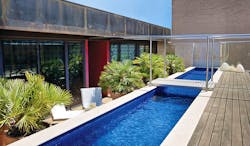
Hotel Granados 83 is a 4-star boutique hotel offering a taste of avant-garde luxury in a central location. Excellent cuisine, modern design and comfortable accommodation make it an ideal spot to recuperate after enjoying the culture of Barcelona.
Standard double room
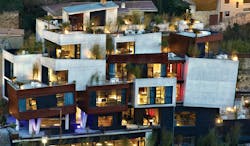
Hotel Viura is a 4-star hotel in a striking modernist building situated in a traditional wine village. Cuisine and wine are a strong focus here at the heart of Rioja wine country.
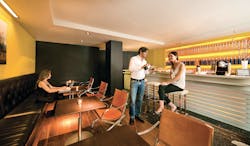
Hotel Miró is a contemporary 4-star boutique hotel situated at the centre of Bilbao's Golden Mile. Excellent spa and wellness facilities, delightful art collections and a complimentary bar offer guests a relaxing haven after enjoying Bilbao's cultural highlights.
I enjoyed every minute of the tour. Cindy-Marie was simply fantastic and her knowledge, kindness and humour was all that I could have asked for. This was a first class experience. Thank you for making it all happen.Customer on Tuscan wine tour, June 2022
Holiday price guide Prices from £1,860 per person based on two people sharing a double or twin room.
Holiday Code SNBR01
Call us on 01392 441245
Luxury touring holiday by train to Barcelona, the vineyards of La Rioja and Bilbao, returning by air
About Barcelona
An Expressions tailor-made holiday to Barcelona include the very best four and five star hotels in the city, all of which provide a superb base for a short city break or as the starting point for your holiday to Catalonia. First founded by the Romans, Barcelona is now a dynamic and cosmopolitan city on the Mediterranean coast which is charming and exciting all at once. The capital of Catalonia is famed for its staggering concentration of Gothic architecture as well as surreal wonders such as the Sagrada Familia, making it one of the most visited cities in Europe. Previously a relatively overlooked industrial city, Spain’s second city played host to the Olympic Games in 1992, prompting a period of extensive regeneration and leading to its reinvention as a lively holiday destination. Unique architecture, a rich culture with art galleries and museums abound, gourmet restaurants, lively bars, designer boutiques, golden beaches, parks and gardens – Barcelona has it all. An exhilarating destination for a city break, with much more to discover...
Highlights of Barcelona
There are a huge number of day trips and excursions which those on holiday in Barcelona can enjoy. These include: The Monastery of Montserrat, a religious complex in a spectacular setting atop craggy mountains with chapels, hermits’ caves and numerous nature trails, reached by a one hour train journey followed by an exhilarating cable-car ride; Wineries in towns such as Sant Sadurní d’Anoia and Vilafranca del Penedès, both around one hour away by train; Catalan towns and cities including Tarragona (a port city with fascinating Roman remains), Girona (an ancient walled city with a fascinating history), Vic (a quintessentially Catalan town with an outstanding market) and Figueres (home to the renowned Dalí Theatre-Museum), all of which can be easily reached by train or bus.
Cultural highlights of Barcelona
There are numerous places of interest that visitors should see during their luxury holiday in Barcelona: La Rambla, Spain’s most famous street which is busy at almost any time of the day or night with flower stalls, tarot readers, musicians and mime artists lining the wide walkway which is shaded by trees. The Gothic quarter, a maze of narrow streets and plazas in the old town with architecture dating back to the 14th and 15th centuries. This historic area is home to Catalonia’s government building, the town hall, a former royal palace and the imposing and intricately-decorated La Seu Cathedral, which includes a beautiful cloister. Montjuic, a fortress-topped hill in the south of the city with museums, art galleries and restaurants dotted throughout the spacious gardens. This is also the setting of the 1992 Olympic stadium, the large open space enjoys panoramic views of the city and sea, and is accessible by cable car from the port, by funicular from the base of the hill, by bus or on foot. The harbour area, where almost 3 miles of sandy beaches meet the Olympic port and the older area of Barceloneta, known for its numerous fish restaurants. Parc de la Ciutatella, a popular park with gardens, a boating lake, a zoo, several museums and the striking Catalan Parliament building. Eixample District, a vast area towards the north of the city which was built according to a grid system and is full of unique buildings which were designed in a ‘Modernista’ (Catalan Art Nouveau) style by the famous Antoni Gaudí and his contemporaries. The most famous building which was designed by Gaudí is the Sagrada Familia, an unconventional church building which is filled with symbolism but is still unfinished. Other famous works of art which feature Gaudí’s trademark curved lines, decorated chimneys, elaborate wrought iron and mosaic decorations include Parc Guell, a colourful park which is a UNESCO World Heritage Site; Casa Batlió, a house with a fascinating interior and exterior and La Pedrera, a curved apartment building.
Gastronomy in Barcelona
Cuisine in Barcelona is similar to the rest of Catalonia, taking inspiration from both nearby France and from central Spain whilst making use of local ingredients available including seafood, fresh vegetables, meat and game. Typical dishes include ‘Crema Catalana’ (a Catalan version of a Crème Brûlée), ‘Pa amb tomàquet’ (bread smeared with tomato, oil and garlic), ‘Fideuá’ (a variant of Paella which uses pasta in place of rice), ‘Zarzuela’ (a seafood stew which is made with fish, prawns, squid and mussels), ‘Escudella’ (a stew containing vegetables, meat, rice and pasta) and unusual ‘sea and mountain’ combinations which use both meat and seafood. Barcelona is home to some of Spain’s best restaurants, with gastronomic chefs creating innovative cuisine and over 20 boasting at least one Michelin star. The best fish and seafood can be found in restaurants in the Barceloneta district, or if you want to buy some local produce yourself then head to the busy La Boqueria market on La Rambla.
Climate in Barcelona
Late spring and early autumn are the best times to go on holiday to Barcelona, as the weather is warm with temperatures of around 20 degrees centigrade. Summer is often unbearably hot with some shops and restaurants closing in August as locals leave the city to get away from the heat. Winter is mild with occasional rain and average temperatures of 10 degrees but is an enjoyable time to visit as Christmas markets are held and many celebrations take place.
Call us on 01392 441245
Luxury touring holiday by train to Barcelona, the vineyards of La Rioja and Bilbao, returning by air
About Spanish Basque country
An Expressions tailor-made holiday to the Basque Country in northern Spain include the very best four and five star hotels across the region, including seaside retreats, city properties and vineyard hotels in La Rioja. Lying at the point between the Pyrenees and the Bay of Biscay is the Basque Country, a name which refers both to an autonomous community within Spain and to a larger cultural area which comprises parts of Spain and France. Known in Spanish as the Pais Vasco, you will find a unique culture here with fascinating traditions and a regional language which is widely spoken throughout. The region's key attraction is the closeness of both sea and country - the spectacular coastline boasts sweeping sandy beaches and rugged cliffs, stunning sunsets over the ocean and surf breaking on rocks; but only a short drive inland are rolling green hills and flower filled fields. Lying around 10 miles away from the north coast is the vibrant and energetic riverside city of Bilbao, whilst further east is San Sebastian, an elegant seaside resort set on a beautiful bay only a few miles away from the French border. Stretching away from the Basque coast and forming the border with France are the Pyrenees, where rocky mountains with waterfalls and lakes stretch into Navarre, a region which is dotted with unspoiled villages and mediaeval towns which line the pilgrimage route to Santiago de Compostela. Further west are the undulating hills of La Rioja, a region whose name is synonymous with the fine wines that it produces. Although parts of the region are heavily industrialised, there are many areas of unspoiled countryside as well as over 150 miles of coastline, making it a superb destination for a luxury holiday. The natural environment has long played a huge role in the lives of the region's inhabitants, with charming fishing villages along the coast which celebrate marine festivals as well as mountain farmers inland whose traditions remain unchanged. Throughout the region, visitors are sure to experience the unique culture of the Basque country through its language, cuisine and traditions.
Cultural highlights of Spanish Basque country
Bilbao's Guggenheim Museum, a Frank Gehry-designed landmark which transformed the city. The charming old town of San Sebastian, located between the beach and the river. Vitoria-Gasteiz, the capital of the Basque Country which is home to a mediaeval old town and two cathedrals. Guernica, a small town which was bombed during WWII and inspired a famous painting by Picasso. Fishing villages between Bilbao and San Sebastian including Bakio, Bermeo, Zumaia and Lekeitio, some of which are home to wonderful beaches and are also popular surf spots. Hondarribia, a historic town situated on the border with France. Pelota, a traditional ball game which is played throughout the region on a two-walled court. Numerous bars across the region which serve ‘pinchos’ (a Basque version of tapas), including those in Logroño. Wine-producing towns across La Rioja where visitors can enjoy cellar tours and wine tastings, which can also be enjoyed at the luxury vineyard hotels which we feature. Yuso and Suso Monasteries, a UNESCO World Heritage Site in La Rioja. The fortress city of Pamplona, renowned for the annual bull running festival.
Gastronomy of Spanish Basque country
The Basque Country is renowned for its varied and innovative cuisine, with numerous Michelin-starred restaurants found across the region. San Sebastian alone is home to eight Michelin-starred restaurants, two of which have been included within the top ten of Restaurant magazine's list of the world's 50 best restaurants. Wine is of course an incredibly important product, primarily in La Rioja which is known for its high-quality reds as well as a number of good white and rosé wines. A regional variation of tapas called ‘pinchos' can be found throughout the Basque Country and Navarre, frequently eaten as a snack in bars. Regional cooking varies according to location, with plenty of fresh fish and shellfish to be found along the coastline and a greater use of meat and game further inland. Local dishes include ‘Bacalao' (salt cod), ‘Marmitako' (fresh tuna stew), ‘Cordero al Chilindron' (spicy lamb stew) and ‘Txangurro relleno' (stuffed spider crabs).
Festivals in Spanish Basque country
19 to 20 January: San Sebastian Drum Festival, 29 June: Haro Wine Festival, 6 to 14 July: Los Sanfermines Bull Running Festival (Pamplona), July: San Sebastian Jazz Festival, 4 to 9 August: Festival of the Virgin Mary (Vitoria-Gasteiz), August: Bilbao's Big Week, September: San Sebastian International Film Festival, September: San Mateo Wine Festival (Logroño).
Climate in Spanish Basque country
The Basque Country's climate is generally quite mild and wet, although there is some variation between coastal and inland areas. The Basque coast experiences relatively high levels of rainfall, cold winters and warm summers where temperatures regularly reach 25 degrees, whilst some areas further south enjoy a Mediterranean climate, with hot summers and little rain.
Call us on 01392 441245
Luxury touring holiday by train to Barcelona, the vineyards of La Rioja and Bilbao, returning by air
About La Rioja
La Rioja, by Spanish standards, is a small and compact region in the north of Spain, to the south of the Basque country and north of Castile and Leon. Sheltered from the Atlantic by the Sierra de Cantabria, La Rioja is a region whose name is synonymous with the high-quality wine produced in over 500 wineries. The vineyards form a patchwork on gently rolling hills and terraces above the valley of the River Ebro and are divided into three zones: Rioja Alta, Rioja Alavesa and Rioja Baja. Each of these areas has a wine route the visitor can follow. Many of the wineries have been run by the same families with expert knowledge passed through the generations for centuries, whilst others are set apart by their stunning modern architecture. The Marques de Riscal winery is one place which combines both elements; founded in 1858 it is one of the oldest wineries in La Rioja but is also known for its iconic building which was designed by world-renowned architect Frank Gehry. As well as the wineries, La Rioja is also known for its cultural significance and magnificent religious buildings. The town of Santa Domingo de la Calzada is a key stop on the St James’ Way pilgrimage route which traverses northern Spain and the cathedral here is well worth visiting. Meanwhile in the city of Logroño guests will find the Cathedral of Santa María de la Redonda with its twin baroque towers and elegant façade. The Ebro River winds lazily through the city and visitors can enjoy a relaxed, self-guided tour of the town, stopping in at the many bars to try the local pintxos paired with local wines.
Highlights of La Rioja
Wine-producing towns across La Rioja DOC region where visitors can enjoy cellar tours and wine tastings, which can also be enjoyed at the luxury vineyard hotels which we feature. La Rioja is subdivided into three zones; Rioja Alta, Rioja Baja and Rioja Alavesa. Follow the wine routes of each of these areas. The beautiful Iglesia de San Bartolomé and cathedral in Logroño. The Cathedral of Santo Domingo de la Calzada, stopping point on the Saint James’ Way pilgrimage route. Numerous bars across the region which serve ‘pintxos’ (a Basque version of tapas), including those in Logroño. The attractive old town of Haro. The Museum of Wine Culture in Vivanco. San Millán Yuso and Suso (Upper and Lower) Monasteries, a UNESCO World Heritage Site in La Rioja, known for their role in the early development of the Spanish language. The hilltop walled town of Laguardia. Walking and nature watching in the Sierra de Cameros Natural park near Soria. “El Barranco Perdido” paleontology-themed amusement park. The pretty village of Ezcaray in the Oja River Valley, made wealthy by the wool trade, is popular with visitors for its outdoor pursuits and host of tapas bars.
Festivals in La Rioja
April: “Los Picaos” Easter procession in San Vicente de la Sonsierra. May: Saint’s Day festivities in Santo Domingo de la Calzada. June: Festivities of San Bernabé in Logroño, Haro Wine Festival and the Battle of Wine, Briones Medieval Festival. August: Bread and Cheese Festival in Quel. September: San Mateo Wine Harvest Festival (Logroño).
Gastronomy in La Rioja
La Rioja is best-known for its high-quality reds as well as many excellent white and rosé wines. A regional variation of tapas called ‘pintxos’ can be found throughout La Rioja, frequently eaten as a snack in bars. Enjoying pintxos like a local means visiting several bars and trying one or two small dishes in each, accompanied by local wines. Regional cooking varies from place to place but the key flavours and ingredients are simple and wholesome with high quality products from the region. Of particular note are the traditional stews made with fava or caparrón beans and a wide array of vegetables and pulses. Christians and Muslims have each left their mark on the region with pork and lamb forming popular bases for dishes, whilst fish caught from the Ebro also appear on the menu.
Climate in La Rioja
La Rioja is one of the colder regions of Spain and tends to have fairly mild summers and wet winters. The preferred time for visitors tends to be from June to September with most tourists avoiding the winter months of November to March. This part of Spain escapes the fierce summer heat found in the centre and south of the country with pleasant temperatures of around 20-25 degrees typical.

